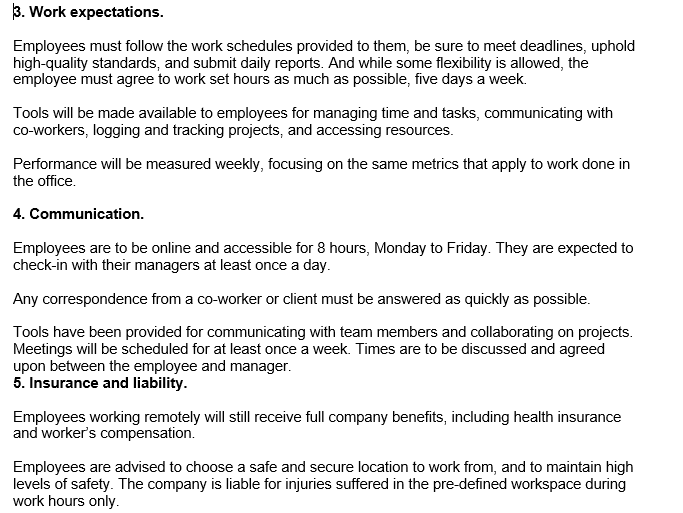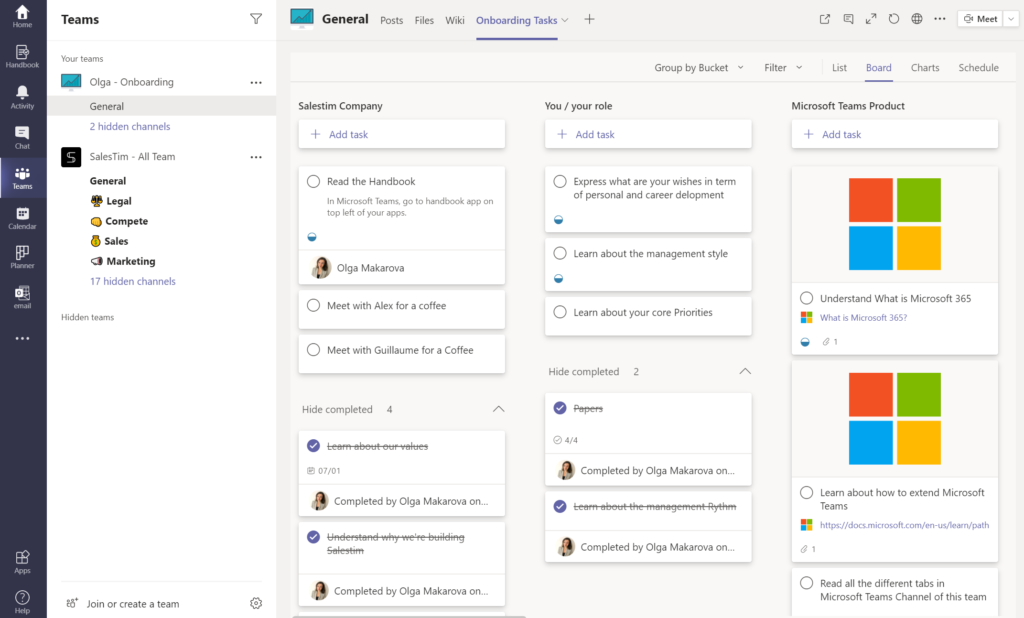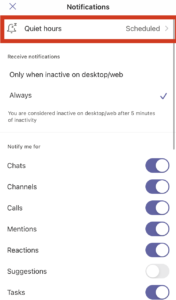While the notion of remote working isn’t new, it has become widespread to this extent only recently. As a response to the covid-19 pandemic many organizations were forced or opted to shift their operations to home office. However, many of us are so accustomed to the old way of working, that we still resort to old office practices even when we’re on our own with our laptop.
These practices are not always effective for remote working and moreover, can impede our productivity. Establishing a healthy remote work culture becomes key to breaking those habits and helping remote teams excel at what they do.
Previously we’ve identified key pros and cons of remote working. Today, we will share with you some tips on how to build a positive work culture that would benefit both your organization and employees with the help of Microsoft Teams.
- 1. Formulate your company’s values
- 2. Communicate your expectations
- 3. Define roles and responsibilities
- 4. Establish a strong onboarding process
- 5. Talk with your team
- 6. Check up on each other
- 7. Set up regular virtual meetings with clear agenda
- 8. Encourage your team to configure notifications
- 9. Create polls for discussing new ideas
- 10. Track your team’s wellbeing
How to build a healthy remote work culture with Microsoft Teams?
1. Formulate your company’s values
First things first – before nourishing your work culture, you need to take time to formulate your company’s values. Holloway describes it as a key step for driving business success.
These values serve as a compass for decision-making and inspiration to work towards achieving collective goal. You also attract the ‘right’ talents that share your values and demonstrate to your clients and partners what your organization stands for.
In order to formulate your company’s values, ask yourself:
- What’s the most important thing to your company?
- What would you like to achieve?
- What do you strive for?
- Which qualities do you value most?
Here’s an example of values by Coca-Cola.

Make sure to communicate your company’s values both to your staff and external stakeholders.
It is not enough to share them once at a corporate meeting. Your values should be visible to everyone at their workplace and be a part of your communication strategy.
To do so with Microsoft 365, create a SharePoint Site where you would describe your company’s culture, way of working, roles and responsibilities, and include a section of your company’s values.
Make this site a tab in the General channel of your organization’s corporate team to ensure it’s accessible and visible to everyone in the company.
You could also leverage Microsoft Teams Live Event capability to communicate your company’s values and culture in a remote way.

2. Communicate your expectations
It is important to establish rules of remote working specific to your organization. Let your remote workers know what is expected from them.
Do they have to work 9-5 or are they are free to choose their own schedule? Or perhaps they will need to be present at certain meetings at a dedicated time and the rest of the working day they are free to stick to their own working hours?
Flexible working day can mean different things for different people. To avoid any confusion, set up how many hours you expect employees to work: when to start, when to finish, how much work should be done, and so on.
Try to give as many details as possible and make sure to share these rules in advance so that they know what they’re signing up for.

In Microsoft Teams, if you create an Onboarding team for each of your new hire, you can specify these rules in a word document and then add it as a tab in a specific channel.
If you decide to follow our previous recommendation and create a SharePoint Site where you would formulate your company’s culture and values, you can also add a page describing remote working rules and expectations.
Find out more about how you can use SharePoint in your organization.
3. Define roles and responsibilities
Another important moment. It often happens in the workplace that a person takes charge of activities that are not their direct responsibilities. Or the other way around, an employee is supposed to be in charge of certain tasks but has no idea about it.
This happens due to lack of communication and written documents stating roles and duties of the staff.
To address this issue, you can create a document, formulating responsibilities of all the different departments within your company. If you work in a big organization, you can ask managers of each department to specify duties for each employee.
Do not leave it entirely up to your employees to decide who’s in charge of what. It is great if they can do it, but oftentimes they will need help to distribute tasks, especially in young teams. This way you’ll make sure all the activities are covered and no tasks are repeated.
Add these guidelines in your SharePoint Site or write them in a Word document and as a tab in relevant teams to make sure this information is accessible to everyone.
4. Establish a strong onboarding process
Difficult onboarding is one of the greatest challenges of remote working, that we discuss in detail in our article Remote Working Pros and Cons.
Fresh grads are not the only ones who need help, even experienced professionals will need assistance to adjust to a new environment and learn about new responsibilities.
To make this initial period less stressful for your new hires, establish a strong onboarding process.
You can easily do it with Planner with Microsoft Teams.
(P.S. This is exactly how we do the onboarding here at SalesTim)

Create a list of tasks for your new employees, add comments to each of them to help them understand what they need to do. Attach files and links to learning materials, tutorials and other documents they need to work on. You will be able to track their progress and help them set deadlines for different tasks.
Would you like to have a pre-built onboarding template with pre-configured tabs and apps? There are lots of use cases that you can benefit from. Contact us and we’ll help you get the best out of Teams.
And don’t forget to introduce new hires to the whole team through a virtual meeting. This will make them feel welcomed and will set you on the right track for establishing good working relationships within a team.
To make these virtual meetings more engaging and to break the ice you can prepare a list of creative questions that will help your team members better know each other.
5. Talk with your team
It’s hard to be productive 100% of our working time. We need breaks, some distractions or simply switch to a different work activity.
Try using it as a way to connect with your employees. Create a Fun channel in your team where your teammates will share not work-related stuff.

Choose a day, say Friday, and dedicate a specific time when you will engage with your team through this channel. You can ask them to share their experience during certain events or simply ask everyone to answer simple questions. For example: What made your week? What made you smile today? What’s the last song you listened to? What are you going to do this weekend? What’s your spirit animal?
These questions will help you understand your colleagues on a more personal level and can help establish a bond with your colleagues.
6. Check up on each other
Your remote workers might miss coffee and lunch breaks at the office when they could socialize with their colleagues. Encourage having virtual breaks, or set up a specific day and time where you will gather all of your team in a virtual meeting and just have a talk for 15-20 minutes about how everyone’s day goes.

See how well your team responds to this kind of meetings and if you get a positive feedback, make it a weekly thing! This will foster team spirit and motivate your staff for the whole week ahead.
To do so, you will just need to use Calendar in Microsoft Teams, configure the day and time of the meeting and choose to repeat it weekly.
7. Set up regular virtual meetings with clear agenda
One of the challenges of remote working in some organizations is overcompensating for the lack of physical presence in the office by organizing multiple virtual meetings. In order to avoid that and to foster remote work culture, make sure that all the meetings have a clear agenda.
Plan every meeting beforehand, communicate to your team what kind of topics will be discussed at each meeting. This will help them organize their work better, prepare questions in advance, and plan their weekly work. Additionally, it will help you avoid holding ad-hoc meetings each time a new question arises, unless it is an urgent matter.
Set up monthly meetings for analyzing your organization’s, department’s or team’s performance, weekly meetings for reviews of specific tasks, etc.
Try to give your meetings a structure. This will ensure you and your teams get the most value out of team meetings and will have more time on performing their main duties.
To ensure the time for these meetings suits everyone in a team, use Scheduling assistant in Microsoft Teams that will help you choose the right time slot. Then choose the frequency of the meeting, and you’re all set.

8. Encourage your team to configure notifications
When working remotely, it can be hard to separate your working life from your personal life since they intertwine in the same space.

Everyone should feel free to work whenever they are more productive, that might be on a Sunday night. But at the same time, others might prefer to spend this time with their families and shouldn’t feel obliged to reply to a message sent outside their working hours.
An essential point of a healthy remote work culture is to encourage maintaining the work-life balance and letting your remote teams know that their well-being and personal time matter.
Encourage them to configure notifications in Microsoft Teams on weekends and outside working hours.
Additionally, it will help them stay concentrated on their job if they set a not-disturb mode while working on an important task.
Having personal space while working and especially after work is important to avoid burn-outs and increase job satisfaction.
9. Create polls for discussing new ideas
If you’d like to get your workers’ opinion on some ideas or proposals (e.g. teambuilding activities, the color palette of a post for your social media campaign, Christmas presents, etc.) try engaging them through polls and surveys. There are a variety of apps that you could use for it, both from Microsoft and third parties.
Find out how to create a poll in Microsoft Teams.

This will empower your remote teams, give them an opportunity to share their insights on topics that they might not specialize in but have some great ideas about. Additionally, you will listen to your employee’s voices and create an environment where their opinion is appreciated.
10. Track your team’s wellbeing
Even though there are general good practices for establishing a healthy remote work culture, every organization is unique. You may want to adhere to rules that will be specific to your company and that will work great with your remote workers.
However, to make sure the practices you’ve established drive productivity and wellbeing among your workers, regularly check out Microsoft Teams wellbeing and productivity insights.
This feature will soon be available in Microsoft Teams.
It will allow employees to get personal insights on their performance, have virtual commutes, schedule breaks and even have mindful experiences science-backed meditations. The program will also ask users to evaluate their emotional state by choosing an emoji, that will allow managers to see how their employees are feeling at work.
Teammates will also be able to send praise to each other, encouraging to keep up the good work and making each other feel appreciated.
Manager and leader insights will allow to track change programs that remind team members to preserve quiet days. Among other features, you’ll get weekly summaries to monitoring team’s progress and celebrate success. You will also be able to see if your team members are at risk of burnout and get recommendations for improving your employees’ wellbeing.
You can find out more about Microsoft Teams Insights in this article.
There you have it, 10 tips for establishing a positive remote work culture.
We would love to hear about your experiences! Share with us how you foster remote work culture in your organization.
